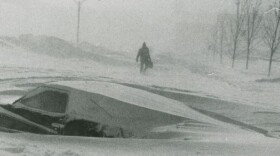The lands along the Niagara River are serene and peaceful today, but two centuries ago, during the War of 1812, they were awash in blood as neighbors fought neighbors and brothers fought brothers.
The first year-and-a-half of the war on the Niagara was deadly: killed in action in various battles, mostly on Canadian soil, were some 300 American, British and Canadian soldiers and militiamen and First Nations warriors. But for the most part, civilians were left alone.
That changed in the frigid month of December 1813 in Newark, as Niagara-on-the-Lake was sometimes called. The Americans, holed up in the town with dwindling supplies, decided to retreat to the United States. Brigadier General George McClure of the New York State militia gave the order to burn the town - a shocking act carried out without warning during a heavy snowfall on Dec. 10. Most of the burning was done by the Canadian Volunteers, a force of American farmers who had settled in Canada but joined the U.S. invaders.
“The burning of the town of Niagara, in which a number of old and infirm persons were left to perish in the snow,” the British commanding officer wrote, was an act “unexampled in barbarity.”
This escalation of the war against civilians unleashed a paroxysm of retributive violence from the British and their Indian allies. On Dec. 18 they crossed the river and took Fort Niagara. Then they marched south, and with the American army gone, the civilian militia could do little to stop them. They exacted vengeance everywhere, burning Youngstown, Lewiston, Manchester (as Niagara Falls was then called) and Black Rock.
Finally, on Dec. 30, they took Buffalo, as most of its panicked citizens fled in the freezing cold. Over the next three days, the British and their First Nations allies, primarily Mohawk, burned every dwelling in the village, with one exception: the small house where the 45-year-old widow Margaret St. John lived. She had stayed behind with two of her daughters, and the British spared her home on Main Street just south of Mohawk.
But Mrs. St. John also owned an inn a few yards away and, for a few terrifying moments on Jan. 2, 1814, it seemed as if she might lose her life because of it. Writing some 63 years later, one of her daughters, Martha, described what happened when an armed officer of the British Army’s Indian Department rode up to the inn and began setting it ablaze.
My mother had just arrived and attempted to put out the fire. At that the Indian, who spoke English, told her she must go to her house, for he intended to burn [the inn]. She said she would have no income if that was destroyed, "and I am a widow and I have also lost my sons." He said: "Very likely that may be true, but we have left you one roof, and that is more than the Americans left for our widows when they came over; they only left the brands of the houses after they were burned." He then drew another pistol, and pointed it at her and said if she wished to save her life she must leave and return to her house they had left for her. My mother said: "I do not intend to risk my life for property..."*
That day the British crossed back to Canada, leaving behind the charred ruins of Buffalo and all the other towns on the American side of the river -- grim vengeance for the burning of Niagara-on-the-Lake. The fighting ceased for the rest of the frigid winter, but the mindless cycle of retaliation did not stop with the warm weather’s return.
In revenge for Buffalo, the Americans burned Port Dover in Upper Canada. The British, in turn, avenged Port Dover by bombarding Stonington, Conn., then sailing their fleet south to lay waste to Washington, leaving the White House itself in flames. Only with the war’s end in early 1815 did the destruction of American and Canadian towns stop. The rebuilding would be left to courageous survivors like Margaret St. John.
*From “Story of the St. John House and How It Was Saved From Destruction by the British and Indians,” a letter written by Martha St. John Skinner to her brother Orson Swift St. John in December 1876, reprinted in Publications of the Buffalo Historical Society, Vol. IX (1906). For contemporary readers, the best history of the War of 1812, including the burning of Buffalo, is Pierre Berton’s The Invasion of Canada, 1812-13 and Flames Across the Border, 1813-14.
Cast (in order of appearance)
Mary St. John: Mary Ann Reisdorf
Indian Officer: Elijah Tyner
Narrator: Susan Banks
Sound recording: Micheal Peters and Connor De Junco (WBNY, Buffalo State)
Sound editing: Micheal Peters
Post-production: Kim Ferullo (Chameleon Communications, 510 Franklin St., Buffalo)
Piano theme: Excerpt from “Buffalo City Guards Parade March,” by Francis Johnson (1839)
Performed by Aaron Dai
Produced by the Niagara Frontier Heritage Project
Written by Jeff Z. Klein
Assistant producer: Karl-Eric Reif
Casting: Darleen Pickering Hummert (Pickering Hummert Casting, 234 Carmel Rd., Buffalo)
Jesse Tiebor (Casting Hall Productions, 2014-15 academic year; Buffalo State Theater Dept.)
Special thanks to:
Brian McDermott, WBNY general manager, 2014-15 academic year
Connor De Junco, WBNY production director, 2014-15 academic year
Anthony Chase, assistant dean, School of Arts and Humanities, Buffalo State
Ronald Smith, professor, and Thomas McCray, assistant professor, Buffalo State Communication Dept.
Webpage written by Jeff Z. Klein





